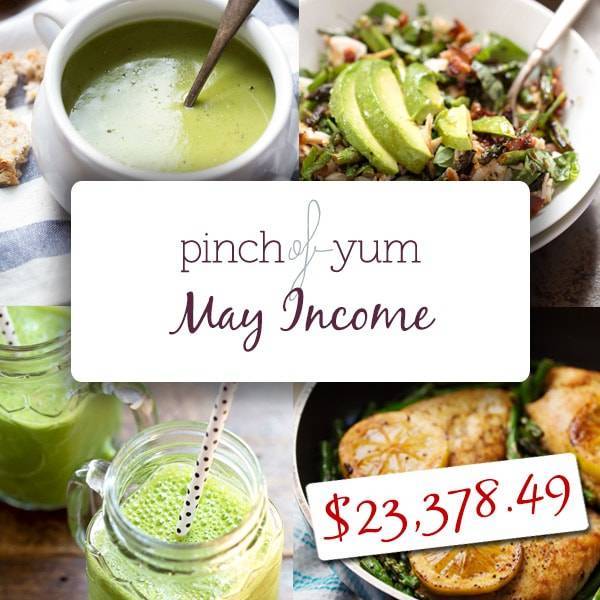
Hey there!
Bjork here, checking in for my monthly traffic and income report. It’s good to be back. I missed you guys.
Lindsay and I have been doing these monthly reports for almost three years now – our first income report was published in September of 2011. We started publishing these reports because we thought other bloggers might have similar questions to the ones that we had (and continue to have).
Questions like…
- How do I build traffic?
- How do I get comments on posts?
- What’s the most important thing to focus on?
- How do I create an income?
- What’s the airspeed velocity of an unladen swallow?
Our day-to-day Pinch of Yum life includes a lot of learning and experimenting to try and come up with answers to questions like these (still working on #5).
While we’ve come up with some answers, we haven’t come up with the answers, so every month I come back and report on what we’ve learned. We talk about what works, what doesn’t work, what we’re working on, and what we wish was working better.
Before I talk about what’s working (and what’s not) this month, I wanted to address one of the most common questions we get from readers and other bloggers.
What Does It Take To Earn An Income From Your Blog?
If I had to say one thing I’d say grit. Grit is the part deep down inside of you that helps you push through when you’d rather be doing something else.
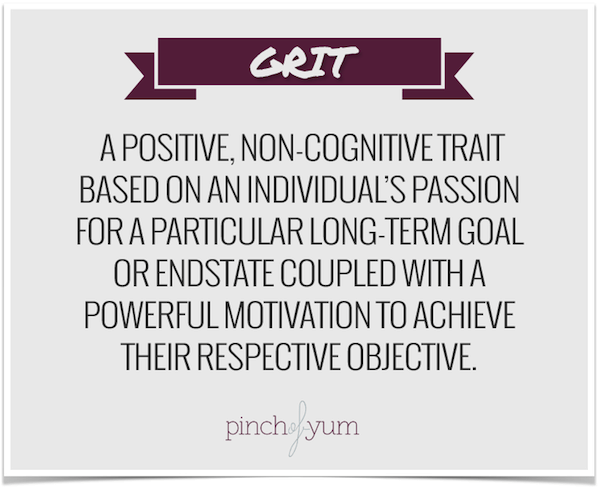
Definition of grit taken from the all-knowing Wikipedia.com.
Do you know successful bloggers? Chances are really good that they’ve published a lot of really good content. Chances are also good that they haven’t always been excited about creating that content. Grit helps you lean into the work and get it done when you don’t feel like it.
In other words, hard work pays off.
If I had to say two things, I would say grit and luck. Being at the right place at the right time and getting noticed by the right people. But know this: the multiplier of luck is grit.
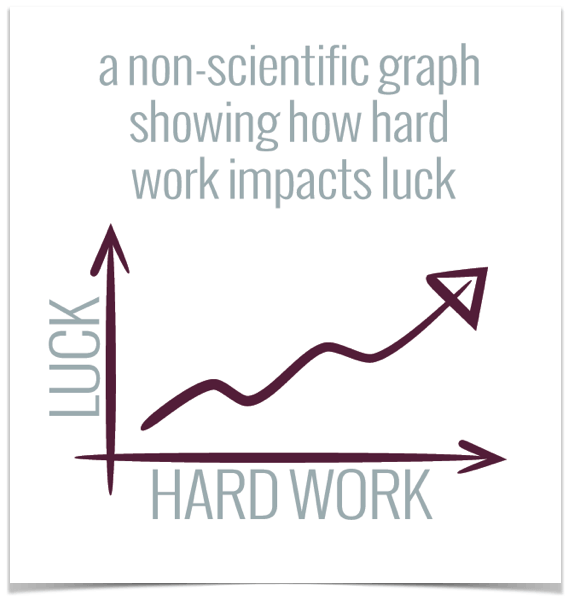
The Beatles were lucky to be discovered by Brian Epstein, the manager that helped to orchestrate their rise to worldwide fame. But they had also played thousands of hours of music together before they were famous. Week after week, night after night, tiny bar after tiny bar. The Beatles’ grit (hard work) served as a multiplier for that “lucky” discovery by Brian Epstein.
In other words, the harder you work the luckier you are.
If I had to say three things it would be grit, luck, and the desire to continually improve. What did The Beatles do after they had their first huge hit? They continued writing music, playing shows, and crafting their skillz (intentional use of “z”).
If you continue to work hard (grit) then you might someday get your break (luck). But if you stop there you’ll be a one-hit-wonder. If you have a desire to continually improve then you’ll be able double down on your previous successes instead of stopping to admire them.
In other words, don’t rest on your laurels.

So what does it takes to earn an income from your blog? Grit, luck, and the desire to continually improve.
**Bjork steps down from his soapbox.**
With that in mind, let’s take a look at the numbers for May.
A quick note: Some of the links below are affiliate links. All of the products listed below are products and services we’ve used before. If you have any questions about any of the income or expenses you can leave a comment and I’ll do my best to reply.
Income
- BlogHer (now SheKnows) – $5,214.53
- sovrn (formerly Lijit) – $4,915.05
- Bluehost – $4,830 –> this income comes from a page where we show people how to start a food blog in three easy steps.
- Tasty Food Photography – $4,344.47
- Everyday Healthy eCookbook – $2,586.25
- Ziplist – $1,771.39
- Yellow Hammer Media – $1,574.90
- Swoop (BlogHer) – $955.83
- Genesis Theme – $834.85
- How to Monetize Your Food Blog eBook – $765.00
- Google AdSense – $638.68
- The Creamy Cauliflower Sauce eCookbook – $254.25
- Elegant Themes – $381.50
- Say Media – $234.47
- Thesis Theme – $130.02
- TapIt! – $89.48
- Gourmet Ads – $66.70
- AWeber – $10.40
Total Income: $29,597.77
Expenses
- Support Staff – $1,640.07
- eBook Affiliates – $1,229.36
- Conference/Class Fee – $600.00
- Food Expenses- $497.88
- Amazon S3 and Cloudfront – $472.85
- Design Work – $450.00
- PayPal Transaction Percentage – $415.91
- Media Temple (Hosting) – $350.00
- RightBanners – $126.00
- Media Temple Optimization – $79.00
- LeadPages – $67.00
- Adobe Creative Cloud – $53.55
- MailChimp – $45.00
- PayPal Website Payments Pro – $30.00
- ViralTag – $28.00
- Easy Recipe Plus – $24.95
- QuickBooks – $21.56
- Stock Files – $20.00
- Time Doctor – $19.98
- E-Junkie – $18.00
- VaultPress – $15.00
- Domain Name Purchase – $10.17
- Google Apps – $5.00
Total Expenses: $6,219.28
Net Profit: $23,378.49
P.S. If you’re interested in learning more about some of the ways that you can monetize a food blog, we encourage you to download this free ebook, “16 Ways to Monetize Your Food Blog,” from our sister site, Food Blogger Pro!
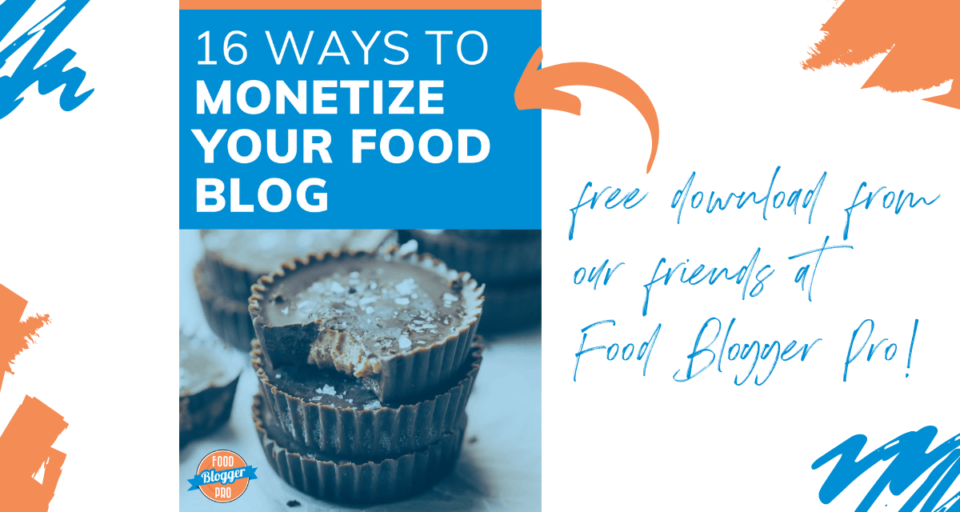
Thoughts On Income
Ad Viewability
Viewability is a term that all bloggers should be familiar with. It’s an advertising term that will soon become standard terminology. My first encounter with the term came from an email sent from BlogHer that started like this:
“I hope this note finds you well! As you likely recall, we’ve been talking about a new advertising standard called Viewability for over a year now. In late March, the Internet Advertising Bureau (IAB) finalized the definition, and in response the entire advertising industry has seen a big uptick in demand for “viewable” ad inventory. I’m writing to share your site’s Viewability percentage and, if necessary, to ask for your immediate help to improve any low-performing ad positions on Pinch of Yum.”
I wasn’t very familiar with viewability so I did some research. Here are the questions I had and the answers I found. Hopefully, these answers help you understand viewability a bit more.
What is viewability?
Three things: An ad is counted as “viewable” if 50% of the ad unit is fully loaded and visible for at least 1 second with no scrolling.
In essence, an ad is considered viewable if someone can actually see it and doesn’t quickly scroll past it.
Why is viewability important?
Brands want to make sure that their ads are actually being shown to people. Makes sense, right? If you were paying $5.00 for every 1,000 impressions of an ad you’d want to know that people were actually seeing those ad impressions that you were paying for.
The bad news for brands using display advertising is that most display ads (54%!) aren’t actually being shown to visitors. The ads might be loading but they’re either (1) below the content and the visitors never scrolls down or (2) above the content and the ad code didn’t load quickly enough before the visitor scrolled down.
Thus the need for tracking viewability.
Viewability gives advertisers an easy to understand metric that shows how often their ad is actually viewed.
What does this mean for my blog?
The biggest thing to be aware of is the start of an industry shift away from the terms “above the fold” and “below the fold.” While these terms will continue to have meaning, their significance will fade as the importance of viewability increases.
This is happening because websites no longer have a consistent “fold.”
Here’s an example. If you’re reading this on your desktop computer, go back to the very top of this post and then grab the corner of the window and move it back and forth (left to right). Do you see how the content shifts and adjusts? That’s because Pinch of Yum is mobile responsive. Many sites are starting to use this type of design to allow for easy reading on multiple types of screens and devices.
When the window gets to a certain width, the sidebar moves below the main content area. The sidebar is usually above the fold, but when the screen is small enough it moves to below the fold.
We can no longer say an ad is either above the fold or below the fold. Why? Because it depends on what type of device someone is using.
While the terms above the fold and below the fold can still be used, they won’t carry as much meaning in the advertising industry. This means that advertisers will start requesting certain viewability percentages as opposed to requesting an ad to be placed above the fold.
But I thought advertisers want ads that are above the fold?
At the core, advertisers want ads that are seen. It doesn’t matter to them where those ads show up, as long as people actually see them.
In the past, companies weren’t allowed to use viewability metrics because the big wig ad regulator people said that the available technology wasn’t good enough to track viewability. That’s why we had to use terms like above the fold and below the fold.
But the big wig ad regulator people recently announced that they think viewability technology is good enough to use, so it’s now okay for the advertising industry to track viewability and require certain percentages. This means that bloggers (like you) are starting to hear about it and are being asked to improve your ad’s viewability.
In short:

What was Pinch of Yum’s viewability percentage?
BlogHer shared the viewability percentage that we were currently getting on Pinch of Yum, which at the time of the email was 21.95%.
Yoiks! That’s really low.
What’s the deal with that?
It’s tough to say for sure, but I think the issue has to do with two things:
1. Our BlogHer ads are above the fold.
It used to be a requirement for our BlogHer ads be above the fold, but with the recent viewability changes, it is now actually a disadvantage. It’s a disadvantage because of how we use photos in our blog posts.
Having a big photo at the beginning of a post means that people are more likely to quickly scroll down to the written content, where they’ll slow down their scrolling. The problem is that when people are quickly scrolling past the image they are also quickly scrolling past our ads.
Remember, high viewability is the new above the fold.
That’s why the best spot to have Pinch of Yum’s ads isn’t above the fold, it’s beside the written content (not beside the images). These are the areas where people are most likely to slow down long enough for the ad impression to be counted as “viewable.”
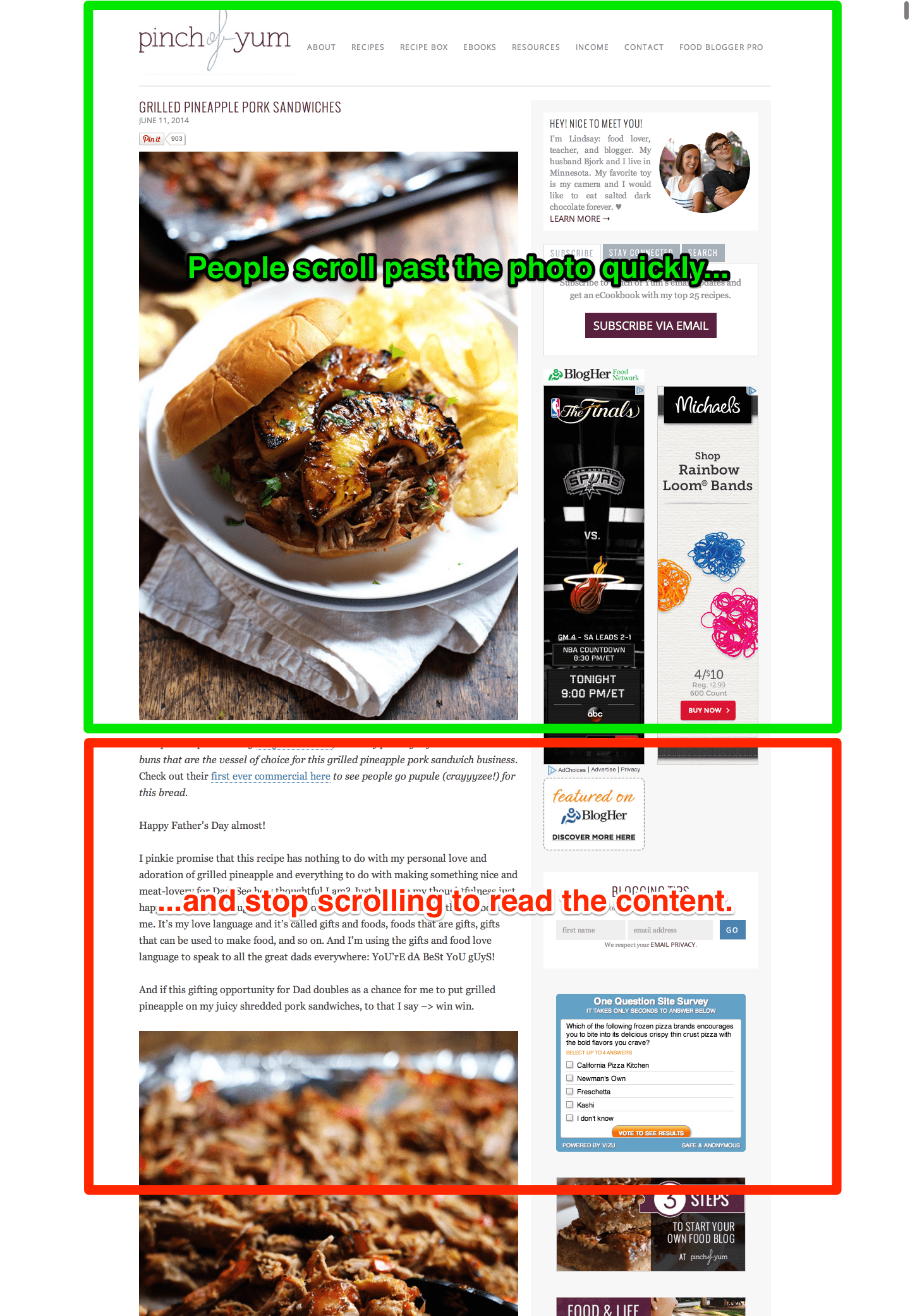
2. Pinch of Yum is mobile responsive.
Most people visit Pinch of Yum on a mobile device like an iPhone or iPad. As we discussed before, the mobile responsive design on Pinch of Yum moves the sidebar down to the very bottom of the site. This means that ads have really low visibility when someone visits Pinch of Yum on a mobile device.
In order to increase our viewability percentage, we could do two things.
- Show ads within the content on mobile devices.
- Hide the ads on mobile devices so it’s not counted against our viewability percentage.
We’ll most likely be moving forward with #2, but we’re not as sure about #1.
Anything else you’d like to add to the conversation around viewable ads? Do you think it’s a good change? Have you heard from other ad networks that are asking you to make changes?
Mobile Ads For The Win (Or Not)
We did a test run with a mobile-specific ad company called TapIt! (the exclamation point is part of the name, I’m not trying to express any excitement about it).
We had a small banner that ran on the bottom of iPhones and iPads. Overall the ads performed poorly. It wasn’t worth it for us to run these ads considering how many impressions we needed in order to create a decent income.
We turned off TapIt! and turned BlogHer mobile footer ads back on.
Has anyone had a good experience with mobile ad companies? I’d love to hear what others have to say about this.
Additional Advertising Companies
We’ve added a few advertisers into the mix and I wanted to report back on those.
We’re using Say Media as a second-tier advertiser on Pinch of Yum (coming in after sovrn). The CPM has been coming in a bit above $1.00 and the fill rate is a low 10%. After that, we’re using Gourmet Ads, which has almost 100% fill with a CPM of $0.43.
We’re continuing to use Yellow Hammer Media in a 300×250 sidebar ad unit. The CPM is around $1 with a fill rate of 100% (which is great!). The issue we’ve had with YellowHammer so far is that the CPM drops really low when we use it as passback, so we’ve had to keep it in as a stand-alone ad unit.
Note: If you’d like to learn more about how advertising works I’d suggest reading Kiersten Frase’s eBook, How to Monetize Your Food Blog (affiliate link). She does a great job explaining the basics of using ad networks and gives suggestions for some networks to start with.
Rpm
RPM stands for page revenue per thousand impressions. Or, in other words, RPM shows you the average revenue you earn from every 1,000 page views on your blog. Below is the RPM that we had for Pinch of Yum in the month of May.

If you want to learn more about RPM (and some other important advertising terms) then be sure to check out this post on Food Blogger Pro.
Traffic
Below are some screenshots from Google Analytics. You can click on these images to view a larger size.
Traffic Overview

Top Ten Traffic Sources
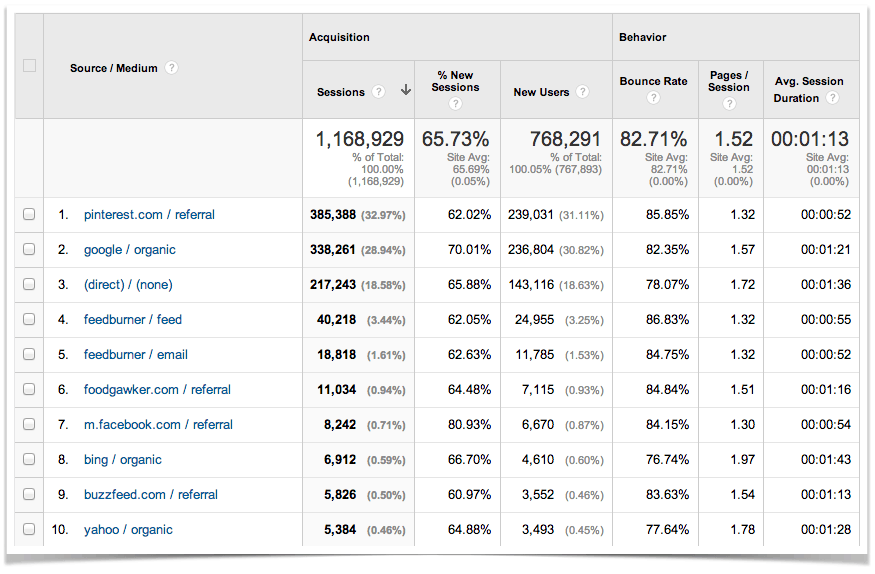
Mobile Vs. Desktop Traffic
(these stats go through June 12th)
I recently set up e-commerce tracking for Pinch of Yum, which means I’m able to see purchase information for Pinch of Yum products. My jaw dropped when I pulled up the mobile vs. desktop analytics and included e-commerce data.

Do you see the staggering statistic in the red box?
The total number of purchases made from a mobile device is zero. ZERO! Isn’t that crazy?
It made me realize that we need to change our strategy for mobile visitors and shift our focus from promoting a product to promoting email sign-ups.
Email signup is valuable because it allows us to continue to communicate with the visitor long after the initial interaction. It might even be better to just pass on the income we’d earn on from mobile ads and direct all of our focus on getting people to sign up for the email list.
Affiliate Marketing and Banner Ads
One of the ways that we drive traffic to our product sales pages is through the affiliate programs that we have set up for each product. After launching Everyday Healthy we had a handful of people that were interested in signing on to be affiliates but we didn’t yet have banner ads created.
I knew that I wouldn’t have time to make the banners myself so I enlisted the help of a company called RightBanners. We’ve used them a few times before and the process has always been really smooth.
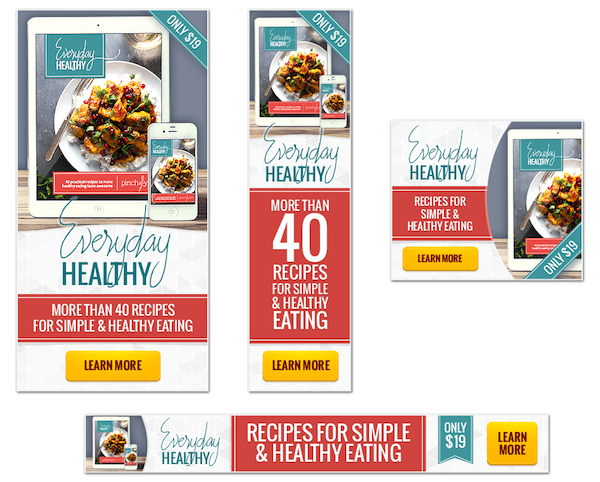
I recently wrote a post on Food Blogger Pro called the best type of affiliate marketing: what it is and why you need to do it. I talk about how we use affiliate programs on Pinch of Yum and how creating your own affiliate program could help you increase your income, even if you don’t have a ton of traffic to your blog. It’s an important concept to understand so I’d encourage you to check it out.
Broken RSS Feed
There were a couple of days in May where the Pinch of Yum RSS email didn’t go out through MailChimp. I didn’t catch it, but we had a couple of readers that were kind enough to let us know that they didn’t get an email that day.
After some troubleshooting and head-scratching, I decided to reach out to MailChimp support to see if they could offer any additional insight. They pointed me to a quality assurance tool from W3C that validates your RSS feed and makes sure there aren’t any errors. After plugging in the Pinch of Yum RSS I found that the feed was broken because of some code that had been carried over from a rough draft that I had written offline and then copied into WordPress (last month’s income report, actually).
This is a great example of the point I made in last month’s report about paying for a service (like MailChimp) versus using a free product (like Feedburner). If not for the support team I would have been left troubleshooting on my own, which probably would have eaten up a good portion of my day.
Because Of You
It’s really true. It’s because of you (yes, you!) that this thing we call Pinch of Yum can exist as it does today. Thanks so much for reading, tweeting, commenting, emailing, and sharing these recipes with your families and friends. We love hearing from you!
We’re using a portion of this month’s income from Pinch of Yum to support one of the special projects at the Children’s Shelter of Cebu, an incredible orphanage in the Philippines where Lindsay and I lived and worked for a year.

This month we’re supporting the Children’s Shelter of Cebu by purchasing some math books so that the kids can have new material for school next year. You can learn more about CSC’s special projects by visiting this page on their website.
